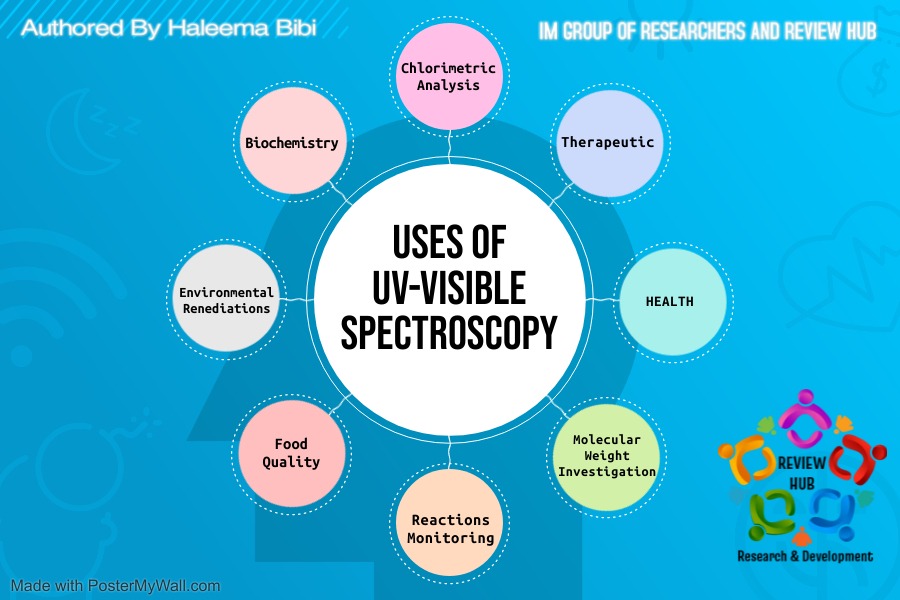Applications of UV-Visible Spectroscopy. Exploring the Wonders of UV-Visible Spectroscopy: A Journey into Investigative Marvels.
Author: Haleema Bibi
1. Quantifying Biomolecules
A vital instrument for the precise measurement of molecules such as proteins, RNA, and DNA is UV-visible spectroscopy. The sensitivity of Uv-Vis to certain chromophores makes absorption measurements possible through high accuracy, providing innovative opportunities for study in biochemistry and molecular biology.
2. Inspecting Therapeutic Formulas
UV-visible spectroscopic study is vital in the pharmacological division for ensuring the eminence of medicine plans. To approve the efficacy and safety of therapeutic possessions, it is very authoritative to start with the concentration of active pharmaceutical ingredients (APIs).
3. Estimates Water Quality
For water quality assessment, environmental experts practice UV-visible spectroscopy. This method supports responsible the environmental care through assisting in the calculation of the wide-ranging health of marine ecosystems through the credentials of impurities and the investigation of absorbance spectra.
4. Colorimetric Chemical Analysis Assays
UV-visible spectroscopy serves as the linchpin in colorimetric assays for chemical analysis. Through the captivating interplay of colors resulting from chemical reactions, it offers a sensitive and rapid means of determining various analytes, showcasing the artistry in scientific precision.
5. Food and Beverage Quality Control
UV-visible spectroscopy turns into a reliable ally in guaranteeing food and beverage safety. This analytical luminary helps unveil adulterants, finely measures nutrient levels, and ensures compliance with stringent quality control standards, safeguarding consumer well-being.
6. Monitoring Real-time Reactions
Scientists delve into the dynamic shades of biochemical reactions using UV-visible spectroscopy. By deciphering absorption spectra variations in real-time, this method contributes to a nuanced understanding of reaction kinetics, akin to decoding the poetry of molecular transformations.
7. Characterizing Nanoparticles in Nanotechnology
UV-visible spectroscopy is a vital tool in the quickly developing field of nanotechnology for figuring out the characteristics of nanoparticles. Sizing up dimensions, discerning shapes, and quantifying concentrations become achievable feats, propelling applications in nanomaterials.
8. Analyzing Transition Metal Ions
UV-visible spectroscopy seamlessly navigates the intricate landscape of transition metal ion analysis. This method excels at location and measurement of these ions, smoothing environmental studies and contributive to coordination chemistry research.
9. Investigates Molecular Weight in Polymer Chemistry
UV-visible spectroscopy is a reliable method for calculation of the molecular weight of polymers. With this introductory understanding, researchers may produce precisely adapted polymers, leading to novelty in a widespread range of engineering applications.
10. Measuring Drug Stability
Pharmaceutical study specifies that UV-visible spectroscopic analysis is a supportive method for assessing the stability of medicines. Scientists validate the consistency and potency of pharmaceutical formulas by tracking variations in absorbance over a specific period. This permits researchers to advance important data into shelf life and storing circumstances.
11. Air Quality Monitoring
UV-visible spectroscopy, with its impact reaching the sky, acts as a silent defender when it comes to air quality monitoring. Through the identification and measurement of airborne contaminants, this application advances our comprehension of the influence of the environment on public health.
12. Researching Coordination Chemistry’s Metal Complexes
Embarking on the frontiers of coordination chemistry, UV-visible spectroscopy illuminates the study of metal complexes. Offering insight into the electronic transitions of metal ions, this method enriches our understanding of their coordination environments, akin to unraveling the secrets of a cosmic ballet at the molecular level.
Conclusion
In conclusion, UV-visible spectroscopy emerges not just as an analytical technique but as a symphony conductor orchestrating diverse applications. Its versatility echoes through various scientific disciplines, showcasing the poetic beauty of analytical chemistry
Also read: Applications of FT-IR Spectrscopy
Follow Us on

